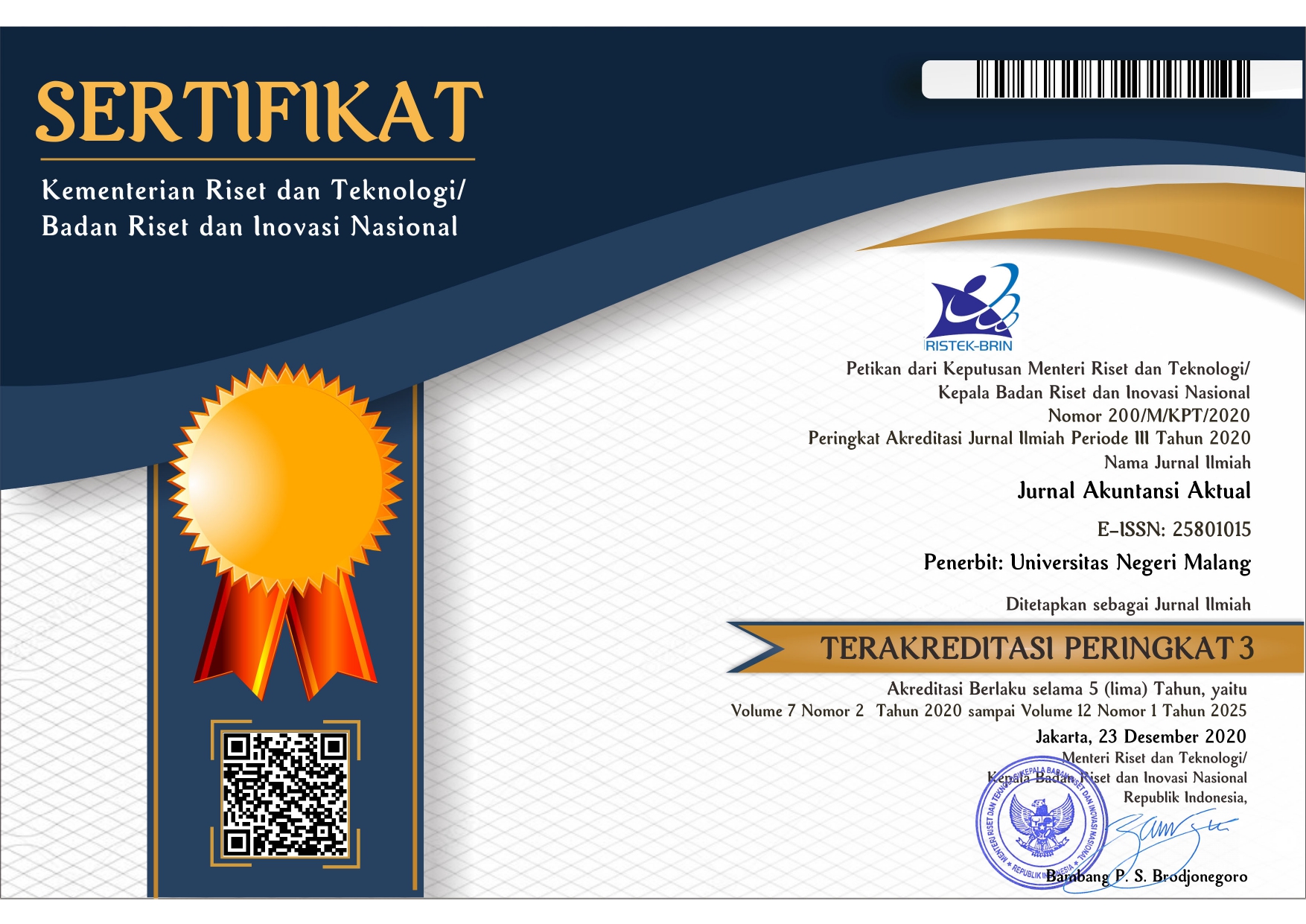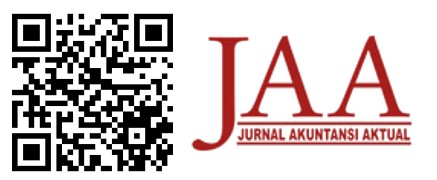PENGARUH KUALITAS SISTEM DAN KUALITAS INFORMASI TERHADAP MANFAAT BERSIH DENGAN INTENSITAS PENGGUNAAN SEBAGAI VARIABEL MEDIASI
Abstract
This study aims to provide empirical evidence of the influence of system quality and information quality on net benefits mediated by the intensity of use. Data collection methods in this study used a survey of respondents who served as financial managers, users of Sistem Informasi Manajemen Pengadaan Langsung (SIMPeL) at offices within the Ministry of Finance in East Java Province and obtained 97 respondents. Data were analyzed by using Structural Equation Model - Partial Least Square (SEM-PLS). The result shows several findings. Firstly, the quality of a good system will affect the intensity of the use of the system and can provide added value in the form of improvements to the performance of individuals and organizations. The second finding shows that the quality of information affects the improvement of individual and organizational performance. Thirdly, the quality of information does not affect the intensity of use. Lastly , the intensity of use has no effect on the improvement of individual and organizational performance. The result of this study can be used as consideration in making improvements in the implementation and development of Sistem Informasi Manajemen Pengadaan Langsung (SIMPeL)
Keywords
Full Text:
PDFReferences
Alshibly, H. H. (2015). Investigating Decision Support System ( DSS ) Success : A Partial Least Squares Structural Equation Modeling Approach. Journal of Business Studies Quarterly, 6(4), 56–77.
Arumsari, K. D., & Winarno, W. A. (2012). Implementasi E-Government System Dalam Upaya Peningkatan Clean And Good Governance Di Indonesia. JEAM, XI(1), 1–19.
Budiyanto. (2009). Evaluasi Kesuksesan Sistem Informasi Dengan Pendekatan Model Delone Dan Mclean ( Studi Kasus Implementasi Billing System Di RSUD Kabupaten Sragen ). Tesis. Program Studi Magister Akuntansi. Universitas Sebelas Maret.
Davis, F. D. (1989). Perceived Usefulness , Perceived Ease Of Use , And User Acceptance. MIS Quarterly, 13(3), 319–339.
DeLone, W. H., & McLean, E. R. (1992). Information systems success: The quest for the dependent variable. Information Systems Research, 3(1), 60–95.
DeLone, W. H., & McLean, E. R. (2003). The DeLone and McLean Model of Information Systems Success. Journal of Management Information Systems, 19(4), 9–30.
Etezadi-Amoli, J., & Farhoomand, A. F. (1996). A Structural Model of End Eser Computing Satisfaction and User Performance. Information and Management, 30(2), 65–73.
Ghozali, I., & Latan, H. (2014). Partial Least Square, Konsep, Metode, dan Aplikasi Menggunakan Program WarpPLS 4.0. Semarang: Badan Penerbit Universitas Diponegoro Semarang.
Hartono, J. (2007a). Model Kesuksesan Sistem Teknologi Informasi. Yogyakarta: Andi.
Hartono, J. (2007b). Sistem Informasi Keperilakuan. Yogyakarta: Andi.
Irmadhani, & Nugroho, M. A. (2012). Pengaruh Persepsi Kebermanfaatan, Persepsi Kemudahan Penggunaan Dan Computer Self Efficacy, Terhadap Penggunaan Online Banking Pada Mahasiswa S1 Fakultas Ekonomi Universitas Negeri Yogyakarta. Jurnal Kajian Pendidikan Dan Akuntansi Indonesia, 1, 1–20.
Livari, J. (2005). An Empirical Test of the Model of Information System Success. The Data Base for Advances in Information Systems, 36(2), 8–27.
LKPP. (2009). Implementasi e-Procurement sebagai Inovasi Pelayanan Publik.
McGill, T., Hobbs, V., & Klobas, J. (2003). Perceptions, User Satisfaction and Success: Testing the DeLone and McLean Model in the User Developed Application Domain. Information Resources Management Journal, 3(4), 87–116.
Noviyanti, N. (2016). Mengukur Kesuksesan Sistem Akuntansi Instansi Basis Akrual (SAIBA) Menggunakan Model Delone & Mclean. Jurnal Tata Kelola & Akuntabilitas Keuangan Negara, 2(2), 151–173.
Oktavia, D. D. (2016). Faktor-Faktor Yang Mempengaruhi Kesuksesan Sistem Informasi Manajemen Daerah Dengan Pendekatan Model Delone dan Mclean Yang Dimodifikasi. Tesis. Fakultas Ekonomi dan Bisnis. Universitas Brawijaya.
Roky, H., & Meriouh, Y. Al. (2015). Evaluation by Users of an Industrial Information System (XPPS) Based on the DeLone and McLean Model for IS Success. Procedia Economics and Finance, 26(0), 903–913.
Samin, R. (2011). Reformasi Birokrasi. Jurnal FISIP UMRAH, 2(2), 172–182.
Seddon, P. B. (1997). A Respecification and Extension of the DeLone and McLean Model of IS Success. Information Systems Research, 8(3), 240–253.
Sholihin, M., & Ratmono, D. (2013). Analisis SEM-PLS dengan WarpPLS 3.0. Yogyakarta: Andi.
Sugiyono. (2015). Statistika Untuk Penelitian. Bandung: Alfabeta.
Teo, T. S. H., & Wong, P. K. (1998). An Empirical Study of the Performance Impact of Computerization in the Retail Industry. Omega—The International Journal of Management Science, 26(5), 611–621.
Urbach, N., & Mueller, B. (2012). The Updated DeLone and McLean Model of Information Systems Success. Integrated Series in Information Systems, 1, 1–19.
Wahyuni, T. (2011). Uji Empiris Model DeLone and McLean terhadap Kesuksesan Sistem Informasi Manajemen Daerah (SIMDA). Jurnal Badan Pendidikan Dan Pelatihan Keuangan, 2, 3–25.
Wang, Y. S., & Liao, Y. W. (2008). Assessing E-government Systems Success: A Validation Of The DeLone and McLean Model Of Information Systems Success. Government Information Quarterly, 25(4), 717–733.
Widodo, T. W., Handayani, S. R., & Saifi, M. (2013). Pengaruh Aplikasi Sistem Informasi Manajemen (SIM) Terhadap Kinerja Karyawan. Profit Jurnal Administrasi Bisnis, 7(1), 87–100.
Wixom, B. H., & Watson, H. J. (2001). Investigation of the Factors an Empirical. MIS Quarterly, 25(1), 17–41.
DOI: http://dx.doi.org/10.17977/um004v5i22018p149
Refbacks
- There are currently no refbacks.

This work is licensed under a Creative Commons Attribution-ShareAlike 4.0 International License.
Jurnal Akuntansi Aktual is indexed by:

















